
When photographers speak tech, laypeople usually don’t have a clue what they are talking about. Well, photography is not just a creative process. It is often determined by sophisticated pieces of technology like camera, lens and some accessories. This is always accompanied by technical terms. Real estate photography in particular, with its special light and space conditions, is not only about the creative eye, but especially about the right technical solution to take realistic and still inviting images. For this reason, anyone who creates real estate photographs should try to understand the relevant vocabulary.
Here follows an explanation of general photographic terms that play a role in real estate photography. I will try not to flood these explanations with further technical jargon, but to keep them generally understandable.
Focal Length Determines the Angle of View
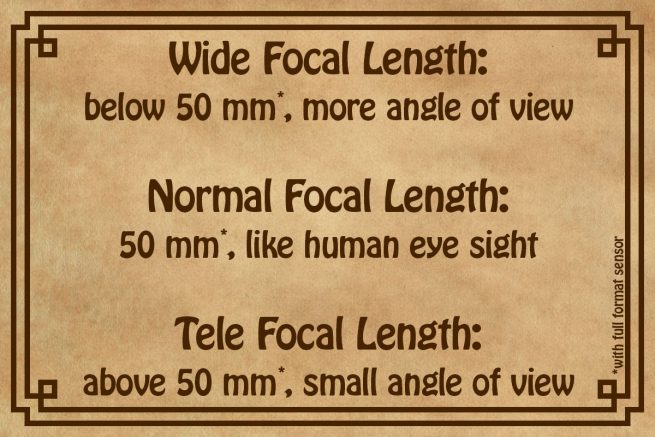
Focal length is a technical term from the physical field of optics. In the photographic sense, it determines the size of the image angle, that we use to capture a scene and is generated by the lens. The lens creates the image on the available surface, the camera sensor.
The image angle of a so-called normal focal length should roughly correspond to the perception with our eyes. A value of 50 mm is assumed to be the normal focal length in conjunction with a camera sensor of the so-called full frame. At 24 x 36 mm, this sensor size corresponds to the 35mm negatives or slides, that we still know from analogue photography on film. For digital cameras with different sensor sizes, the normal focal length has a different value. With the widespread APS-C format (smaller by a factor of 1.5 to 1.6 than full frame), it is around 35 mm.
Values that are above the normal focal length are referred to as telephoto focal lengths. Accordingly, they can be found in telephoto lenses. These show a smaller image section and enlarge it to the sensor area. This generates the impression, that the subject matter is closer to the viewer.
However, focal lengths below the normal lens – so-called wide-angle focal lengths – are interesting for real estate photography. With these it is possible to show a wider angle of view than our eyes are able to capture with a single glimpse. This means that even small rooms can be shown in a single photo. But be careful: you should not overdo this wide-angle effect, as not to raise false expectations on the viewers‘ side about the size of the room.
In addition, the focal length creates other effects in the image, which affect, for example, dimensions and sharpness range.
Aperture Determines the Amout of Light – and more
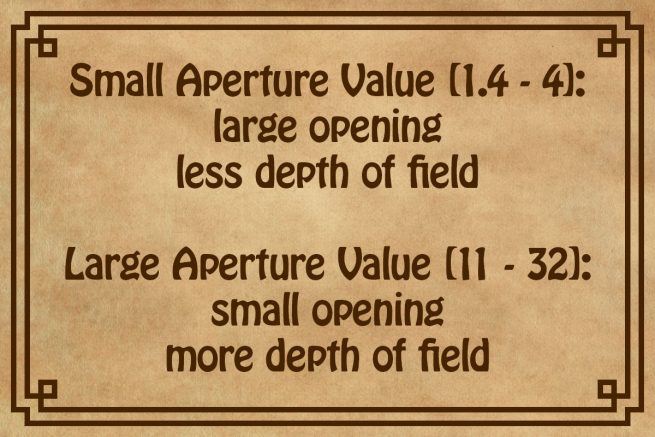
The aperture on a camera is the size of the front opening through which light enters the camera. In most camera lenses, this opening consists of several metal blades, arranged to form a variably sized hole. This allows more or less light to enter the camera. The function is clear: large opening – lots of light, small hole – little light.
The use of associated aperture values may seem somewhat confusing, because a large aperture means a small value, while choosing a large number always results in a more closed aperture. Depending on the lens, large apertures are between 1.4 and 4 and small aperture openings are often above 11.
The aperture required for the right amount of light is determined by the camera’s internal exposure meter in conjunction with other camera settings.
But the aperture is also responsible for another effect – the so-called depth of field, which tells us something about sharpness. It works like this: First you focus the lens on a certain point in the distance. However, according to optical rules, a certain area in front of and behind this point – i.e. in depth – is also sharp. The size of this area is determined by the aperture (and some other settings). A small aperture number provides a large focused area, while a large aperture value for a small depth of field.
In conjunction with focal length and focus distance, depth of field in real estate photos can be controlled quite precisely, so that almost an entire room is sharply imaged from front to back.
With conventional smartphones, there is only one fixed aperture, so the correct exposure must be controlled by other parameters. The effect of a small depth of field is therefore simulated somewhat satisfactorily on modern phones using the camera software.
ISO Value is sensitive
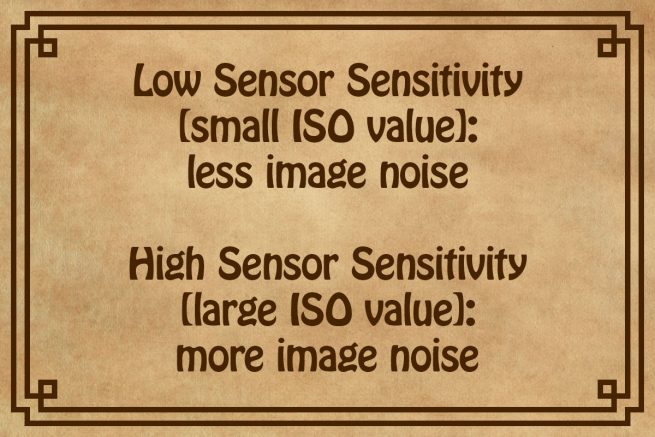
Most cameras allow to adjust, how sensitive they react to incoming light (the amount of which is already controlled by the aperture). What is that good for? If you’ve been paying attention up to this point, you know it: In real estate photography, we close the aperture to get the greatest possible depth of field. However, only little light reaches the camera sensor. Now, by increasing its sensitivity for light, you can counter-act low light and still get a well-exposed shot.
However, the high ISO value has a serious disadvantage: it inevitably creates unevenness in the image – the so-called image noise. If you then send such a photo through the image processing on the computer in order to make more details visible, this image noise is even further amplified.
Therefore it is important for real estate photos not to overdo it and to obtain the required amount of light in other ways. This can then only be controlled by the duration the camera sensor is exposed to the incoming light. This exposure time can also be set specifically on the camera so that it suits the aperture and ISO values. These three values form what is known as the exposure triangle.
There’s also an automatic ISO adjustment, but we don’t know if it creates a lot or little image noise. On smartphones, this is used in the standard apps. This restriction can only be lifted by using special photo apps.
Watch out! Exposure or Autofocus?
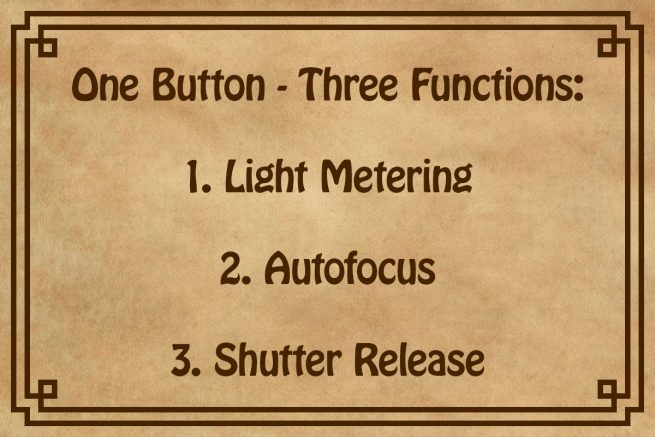
There is one phenomenon that I keep noticing in my photo workshops for real estate professionals: When the photo layman is asked to explain how he photographs, he often mixes the terms related to exposure and focus. They should keep in mind the following: Exposure provides the right amount of light to create a photo. And autofocus is responsible for a sharp image. These are two processes independent from each other.
However – and this may be the reason for this confusion of terms – both functions are initiated using the same button on most cameras. If you press and hold the shutter release button halfway, the camera measures the exposure and sets the correct values. At the same time, it searches for a focus point to focus the lens. If you then fully press the shutter button, the photo is created with all these values. It will be sharp AND correctly exposed.
Experienced photographers separate these functions and assign them other buttons on the camera (function AF-L, AE-L). In my opinion, however, this only makes sense if you are not photographing exclusively static motifs. So it is not important for real estate photography.
White Balance
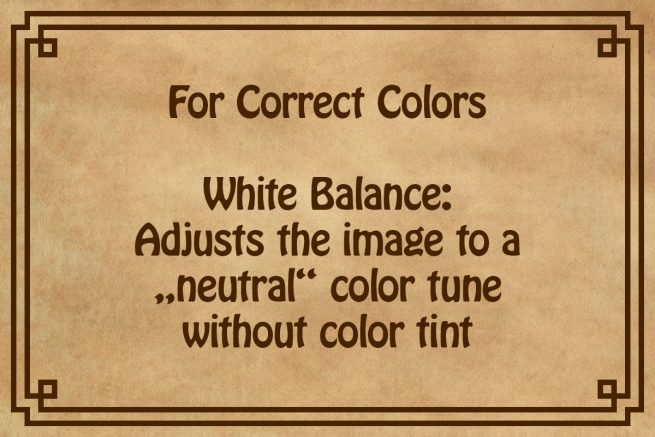
You need light to take photos. However, the light can have very different color tints. For instance: In the morning and in the evening we have warm light with more red components, while at noon there is a cool lighting atmosphere. This is because sunlight travels a shorter distance through our atmosphere and is therefore not filtered by so many particles (e.g. dust and water vapour). Our perception with the eyes only notices bigger differences, while a camera is incorruptible even with small variations.
The same applies to the lighting mood indoors. It is influenced by the type of room lighting or interior colors.
The difference becomes particularly obvious in real estate photography when both extremes meet: cool midday light from outside and warm tones inside, for example due to a beautiful wooden floor.
White balance can help us to get correct colors in at least one of the areas. So that if necessary we only have to correct the other in post-processing. The reference to the term „white“ is somewhat misleading. Technically it is always a tone that is neutral in nature, i.e. gray. So you take a neutral gray area as a reference, adjust the image so that this area also appears neutral gray in the photo. By that all other colors in the image are automatically reproduced correctly. Almost all cameras have an automatic white balance. This works usually quite accurate with good cameras and relieves the photographer of some follow-up work.
Technical Terms: Was that too Much Theory?
Then I can only recommend to deepen these insights in a practical workshop. „Basics of Real Estate Photography“ explains these terms and shows, among other things, how to use their functions for better real estate images.

